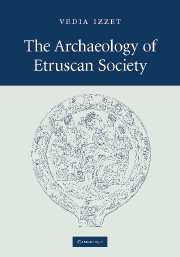Book contents
- Frontmatter
- Contents
- List of illustrations
- Acknowledgements
- List of abbreviations
- Introduction
- 1 Models of change in Etruria
- 2 Etruscan mirrors: reflections on personal and gender identity
- 3 Funerary architecture: the living and the dead
- 4 Sanctuaries: the sacred and the profane
- 5 Domestic architecture: public and private
- 6 Urban form and the concept of the city
- 7 Making Etruscan society: culture contact and (material) culture change
- Bibliography
- Index
6 - Urban form and the concept of the city
Published online by Cambridge University Press: 10 May 2010
- Frontmatter
- Contents
- List of illustrations
- Acknowledgements
- List of abbreviations
- Introduction
- 1 Models of change in Etruria
- 2 Etruscan mirrors: reflections on personal and gender identity
- 3 Funerary architecture: the living and the dead
- 4 Sanctuaries: the sacred and the profane
- 5 Domestic architecture: public and private
- 6 Urban form and the concept of the city
- 7 Making Etruscan society: culture contact and (material) culture change
- Bibliography
- Index
Summary
Introduction
The study of Etruscan cities spans as brief a time as that of domestic architecture. After the somewhat piecemeal excavation of a few sites in the late nineteenth and early twentieth centuries, notably Vetulonia (Falchi 1898) and Marzabotto (Brizio 1891), the first systematic excavation of Etruscan settlements took place in the mid-twentieth century. As a result, traditional studies of Etruscan cities exhibit a heavy reliance on funerary data (see Chapters 1 and 5). As discussed in Chapter 1, the Crocifisso del Tufo cemetery at Orvieto in particular has been used to illustrate the layout of Etruscan cities (Mansuelli 1970b; 1979: 363; 1985: 111; Drews 1981: 148), and the Banditaccia cemetery at Cerveteri has been deployed in a similar way (Gros and Torelli 1988; for doubts about such use of funerary data see Damgaard Andersen 1997). A further similarity with the study of domestic architecture is in the incorporation of urban form into the debate over Etruscan origins. Early in the twentieth century, Haverfield tried to argue that town planning was part of the ‘ancestral heritage’ of Italy, extending back into the second millennium bc (Haverfield 1913: 72). Such an early date has been dispelled by Ward-Perkins (Ward-Perkins 1958: 109–11). However, in more moderate form, the long-term continuity, at least from the ninth century bc, of the process of urbanisation is a generally accepted principle (Colonna 1970: Castagnoli 1971: 75–81; Gros and Torelli 1988: 6–12; Guidi 1985, 1989; Harris 1989).
- Type
- Chapter
- Information
- The Archaeology of Etruscan Society , pp. 165 - 207Publisher: Cambridge University PressPrint publication year: 2007



